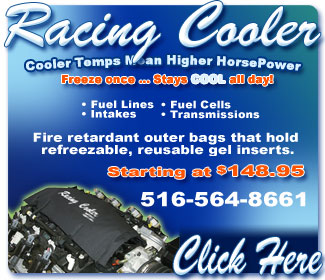.jpg)
This picture is attempting to show the parts
of the cylinder that have "moved out" with
use. The dark areas are where the hone stones
did not touch. The top of the picture is
the deck plate! I lightly honed the cylinders
first just to see where the block wore the
most. This will all be shiny new when I'm
done honing. |

Another stocker rule is that you cannot overbore
more than .070" from stock size. I am going
to be at .062" oversize. That is absolutely
the limit for one of these blocks with block
filler. The cylinder walls get pretty thin when
you bore past .030" over. But, it is the block
I'm using, and it is already .060" over. It
will take a good .002" more to clean it up with
a hone.
Also pictured is the block with a deck plate
attached. The deck plate will help simulate
the distortion the block sees when the cylinder
heads are bolted on. The plate makes a big difference
when you try to get the cylinder's round and
straight within two ten-thousandths of an inch
(.0002") top to bottom. Ring seal and low friction
is the key in any racing engine short-block.
The connecting rods and crankshaft are stock
Ford pieces from my old engine which used the
89 302 HO externally balanced assembly. The
crankshaft is so spindly that it could easily
be mistaken for something out of a Briggs and
Sratten. The good part is that it is really
light. The potential bad part is that it might
break under the stresses of my hopefully newfound
horsepower. I guess we'll find out!
.gif)
Here we see the deck plate bolted to the
block. This helps simulate the stresses
on the block that the cylinder head bolts
exert when torqued to spec. It is VERY important.
|
Also, I am using an ATI Super Damper to control
the harmonics. I use ATI dampers almost exclusively
at my shop because they are the best. The bearings
of choice are Federal Mogul "H" series pieces.
The "H" bearings are affectionately nicknamed
"ugly" bearings because they come from FM without
the silver flash plating you normally see on
standard bearings. The reason for this is that
the silvery tin plating can actually peel off
under high stresses and try to become "as one"
with the crank journals. For bearing clearances
I will run about .0025" on rods and .003" on
the mains. The factory Ford standard pressure
oil pump is plenty adequate and takes fewer
horsepower to turn than a high volume or high-pressure
pump does. Also, it is made from aluminum so
it weighs less. Remember, every little bit adds
up. I can add weight in the rear of the car
if it comes off the front. The piston to cylinder
wall clearance will be about .0055" total. The
unique shape of the CP Pistons skirt allows
me to run a tighter clearance than would normally
be associated with a racing piston and still
have very low drag. The rings are Speed-Pro
Plasma Moly file fit types and I will set the
ADVERTISEMENT
 |
|
end
gap of the top rings to about .016". A stock
or possibly stock replacement type oil pan will
be used and a few baffles added for oil control.
In the next installment I will cover the selection
and installation of the custom ground Comp Cams
hydraulic roller cam I am using and the intake
manifold selection, show some engine assembly
and hopefully have a finished powerhouse to
install in Muscrate. See ya next time! Remember,
life's too short.
When in doubt,
DO
A WHEELIE!!

|